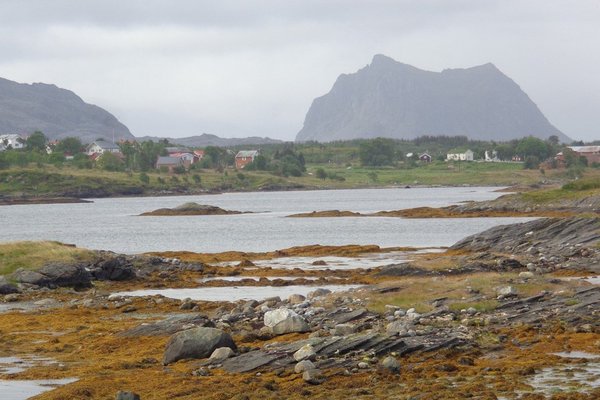Norway
Vegaøyan
Vegaøyan – The Vega Archipelago represents a cultural landscape near the Arctic Circle shaped by farmers and fishermen.
The Vega islands have been inhabited since the Stone Age. People make a living based on fishing and the unique practice of eider down harvesting, which has survived since the 9th century. The farmers built nests for the wild eider ducks that arrive in the breeding season and gather the valuable eiderdown in return after the birds leave.
Community Perspective: the eider ducks arrive in Spring, but tourists aren’t welcome then and the action is mostly on the remote islands which aren't accessible anyway. You’ll have to make do with the World Heritage Center in Gardsøy to get the idea. Nan has described the different ways to get to the archipelago, but look at the ferry schedule first before booking a flight! Also, be aware that the core zone of this site is limited to the west and some small coastal parts of the north of the main island, plus the surrounding seascape.
Site Info
Official Information
- Full Name
- Vegaøyan - the Vega Archipelago (ID: 1143)
- Country
- Norway
- Status
-
Inscribed 2004
Site history
History of Vegaøyan
- 2004: Inscribed
- Inscribed
- Type
- Cultural
- Criteria
- v
Links
- UNESCO
- whc.unesco.org
- Official
-
- visithelgeland.com — Vega World Heritage Area
All Links
UNESCO.org
- whc.unesco.org — whc.unesco.org/
Official Website
- visithelgeland.com — Vega World Heritage Area
News Article
- May 5, 2020 fishfarmermagazine.com — Mowi receives clearance to farm on Vega Islands
- April 10, 2019 fishupdate.com — Farm ban at Vega world heritage site
Community Information
- Community Category
- Cultural Landscape: Continuing
Travel Information
Needs a Ferry
Recent Connections
-
Misleading WHS Names
This does not cover the full archipelag… -
Needs a Ferry
Pedestrian ferry between Brønnøysund an… -
Built in the 6th century
earliest settlement
Connections of Vegaøyan
- Geography
-
-
Marine sites
6881 ha of land within a total area of 107294 ha. -
Archipelagos
See its official title -
Full White Nights
-
- Trivia
-
-
Cultural sites taking up an entire island
this applies to the second biggest island of Sola plus the many smaller islands and skerries rather than to Vega itself. -
Role of Women
"The site is a testimony to women's labour and their control of the eider duck farming."
-
- History
-
-
Neolithic age
"The abundance of resources led to great activity throughout the Mesolithic and Neolithic. So far, Stone Age finds have been recorded at 108 locations on Vega, the majority being habitation sites." (nomination dossier)
-
- Ecology
-
-
Eagles
"Majestic white-tailed eagles .. are a commonplace sight in the Vega Archipelago." (AB ev) -
Inselbergs
"A notable and valuable feature of the Vega Archipelago is the wedge-shaped mountains or "monadnocks". There are two of them on the main island of Vega and a third one forms the Island of Sola" (IUCN eval) -
Otters
"strong populations of Eurasian otters" (nom file)
-
- Architecture
-
-
Wooden architecture
"Dwellings were built of logs, clad externally with vertical planks, traditionally roofed in turf" (AB ev)
-
- World Heritage Process
-
-
Inscribed on a single criterion only
v. to be an outstanding example of a traditional human settlement, land-use, or sea-use which is representative of a culture (or cultures), or human interaction with the environment especially when it has become vulnerable under the impact of irreversible change -
Perfect Inscriptions
2004 -
Minor modifications after inscription
2017: removing the modern farm in Moen, which was included by mistake.
-
- Human Activity
-
-
Hunting or harvesting of Birds
The Harvesting of Eider down from wild birds has long been a significant aspect of the island economy
-
- Constructions
-
-
Lighthouses
Bremstein lighthouse -
Falun Red
-
Purpose Built Visitor Centre
Vega Verdensarvsenter. "The World Heritage Center was officially opened on June 13, 2019 with, among others, HKH Crown Prince Haakon present."
-
- Timeline
-
-
Built in the 6th century
earliest settlement
-
- Visiting conditions
-
-
Needs a Ferry
Pedestrian ferry between Brønnøysund and Rørøy dock on Vega Island, or car ferry from Sandnessjøen.
-
- WHS Names
-
-
Misleading WHS Names
This does not cover the full archipelago, especially large parts of the main Vega island (where you will arrive) are excluded. Also, the title has a ‘natural’ feel, while it is a cultural landscape focusing on the local lifestyle of fishing and eider down harvesting. Suggestion for alternative name: "Cultural landscape of Vegaøyan".
-
News
- fishfarmermagazine.com 05/05/2020
- Mowi receives clearance to farm on…
- fishupdate.com 04/10/2019
- Farm ban at Vega world heritage si…
Recent Visitors
Visitors of Vegaøyan
- Alexander Lehmann
- alicemears
- A. Mehmet Haksever
- Argo
- Atila Ege
- Bin
- Birgitte Sørensen
- Christer Sundberg
- Claire Bradshaw
- Dan Pettigrew
- Elaine McArdle
- Els Slots
- Eva Kisgyorgy
- George Gdanski
- Gjert
- HaraldOest
- Ivan Rucek
- Jarek Pokrzywnicki
- Joel on the Road
- Jonas Martinsson
- Karito Vies
- Marie
- Martina Rúčková
- Mikko
- MMM
- nan
- Nihal Ege
- Patrik
- Philipp Peterer
- Pink Bunny
- Ralf Regele
- Randi Thomsen
- Roger Ourset
- Schnitzel
- Sergio Arjona
- Shandos Cleaver
- Svein Elias
- Tatiana Nikulnikova
- Tom Flaten
- Tsunami
- WalGra
- Wimmy
- Wojciech Fedoruk
- Zoë Sheng
Community Reviews
Show full reviews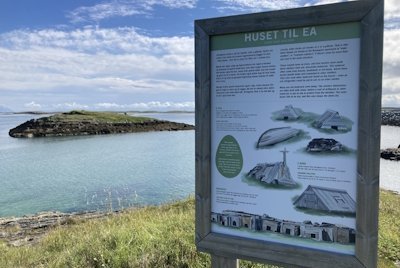
Late June is when the young eider ducks first go swimming with their mums. I had hoped to see some moving around between the small islands and skerries that characterize the Vegaøyan landscape known as 'Strandflat'. But it was not to be, and neither did I see any Stone Age graves. I may have spotted an Eider house from a distance on one of the islands (it may just have been a pile of wood as well), and I did pass a few interesting older farmhouses on my 9km walk up from Rørøy ferry dock to the Vega World Heritage Center. It is mostly the landscape though that is memorable and the ferry ride alone makes a trip worthwhile.
The narrative of the eider down harvesting tradition is a compelling story, but this is not a great WHS. Both regarding (1) composition and (2) presentation:
- As Nan already hinted at in his review, the core zone and the OUV don’t match – at least not on the main island of Vega (the other islands are practically off-limits, they seem “better” but how are we to know). The core zone on Vega island comprises everywhere where no people live and where there are no roads. The OUV however is purely cultural, about the traces people left behind such as old dwellings, eider houses. The photos in the nomination dossier mostly are either of natural features or of cultural elements in the buffer zone.
- The island receives …
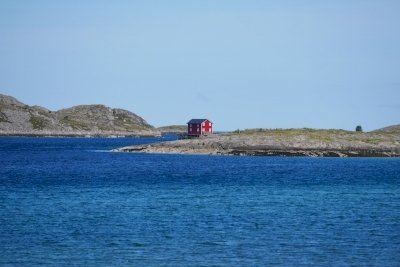
Referring to the site as Vega Island is misleading. The site is called Vega Archipelago and the greatest part of the inscribed area is not on Vega Island but on other islands and the sea in between. Be sure to check the map.
Vega Island is the easiest to reach, though, and it will both provide great views of the inscribed area as well as access to the core zone:
- The mountain on the southwestern side of island is inscribed and there are two climbing trails. There are also the Vegatrappa, stairs leading you up. I rode with my bike to Sundsvollstranda and hiked along the coast. Unfortunately, I missed the stairs; signposting for trails is not really popular in Norway. From the west coast you also have great views of the neighboring islands. Other starting points for the mountains are in Eidem and in the center of the island.
- Holandsosen is a protected area and there is a small trail running through it. I found it less impressive than the west coast.
- In the North East corner is another protected area.
The visitor center itself, as far as I can tell, is not in the core zone, but you get a great view of the archipelago. Best option would be to rent a kayak to navigate between all the small islands. Side note: The visitor center does not sell proper tickets, so I skipped it.
Generally, I don't quite follow …
Keep reading 0 comments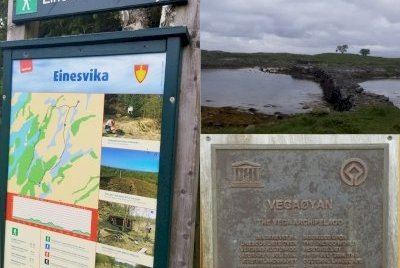
Vega island by itself is a lovely hiking spot for fresh air, some history, flora and fauna spotting. The main issue is that the ferry to the island is expensive enough to turn away potential visitors. There are many places along the coast that have the same scenery without that pricey crossing. The main draw is the eider duck and you have probably read that the ducks aren't easily spotted on the island. In fact they mainly come here during nesting season (April) and during that time visitors are not welcome. Hotels are closed and the locals don't like a silly tourists scaring the ducks away. Every house, every barn, every boat and even wheelbarrow become potential nests for the female eider, forming the connection between ducks and humans it has received world heritage status for. In the end this is about money, as a down jacket from Vega is one of the most expensive pieces of clothing you can imagine to buy. Thus maximizing the amount of eider ducks nesting is the key.
So I visited Vega in early July and it was still rainy and chilly. I saw a few ducks in the fields and marshes. There are a couple of things to do, first is the "museum", rather expensive for a quick tour of the history, and the second is hiking. I spent the rest of the day doing that although the paths were muddy and it wasn't that enjoyable. There were signs for an activity …
Keep reading 0 comments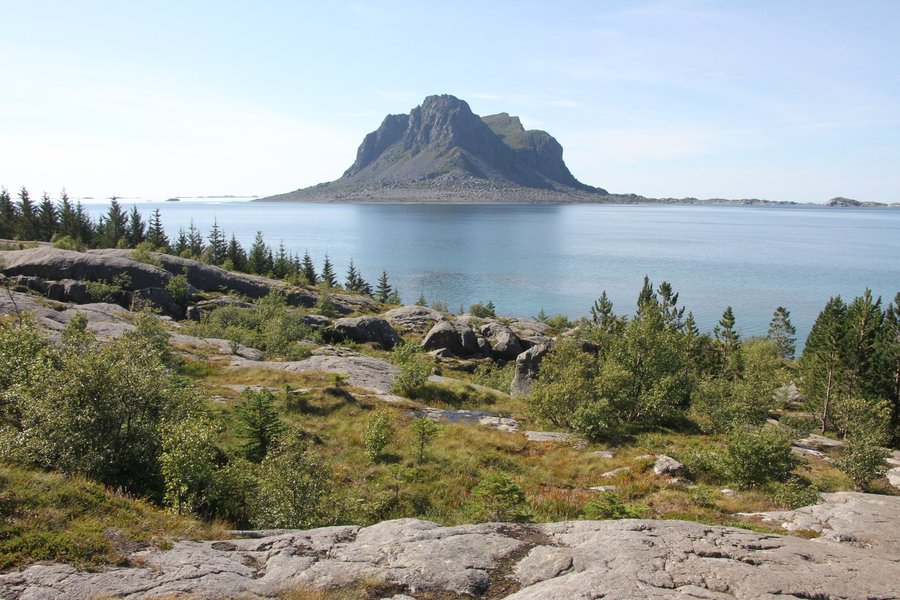
This was quite a tricky site to visit, as it's a fair way off the usual Norwegian tourist itinerary. We spent two nights in a small campground in Salhus, halfway between Bronnoysund and the departure point of the Vega ferry. The archipelago itself is largely uninhabited, and only the main island of Vega seems to be occupied year-round. We drove around for a while looking for some interesting highlights to film and coming up fairly short. Obviously it wasn't duck season, so we couldn't find any nesting eider ducks to look at. The highlight was definitely the eider duck museum near Holand on the northern coast of Vega - there is a World Heritage centre here that was opening "very soon" when we visited in June 2018.
Keep reading 0 comments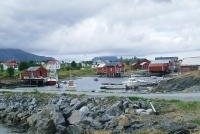
The highlight of my visit to Vega Island was to see the eider duck museum and nearby duck nesting site at Nes on the north coast of the island. I had been directed there by the young man at the tourist office in Gladstad. It was a longish walk but worth it.
I reached Vega Island by a small ferry from Bronnoysund. Many visitors reach Bronnoysund on the daily coastal ferries of Hurtigruten, but I chose to get there by bus from Grong railway station. I also used the bus service connecting the port of Roroy with Gladstad on Vega Island.
Keep reading 0 comments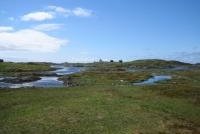
Lost luggage and heavy rain and generally in a bad mode I finally got on the “Hurtig-boat” in Brönnöysund, heading for the island of Vega, the largest island in the Vega archipelago. Once out on the sea, the sun broke through the clouds and the harsh and rugged beauty of the 6500 island suddenly became friendly and inviting. My first stop before heading further out in the archipelago was my hotel, the Vega Havhotel, a hotel that turned out to be a virtual gastronomical paradise with guests from all over Norway and from abroad. So visiting Vega without staying at Anna and Jon Aga’s Havhotel would be a major loss.
Having chartered a boat, I proceeded out into an archipelago with its flat, small island without almost any vegetation, making me wonder how people actually have survived out here. But so they have for over 1500 years, fishing, hunting and also harvesting the down of eider ducks. Even though the outer islands of the Vega archipelago is only inhabited in the summer time, the harvesting of eider ducks is still done today but you will have to be ready to pay some spare 7.000 dollars if you want to take a pillow with you home.
If you want escape civilisation for a weekend and feel the beauty as well as the roughness of northern Norway’s Atlantic landscape paired with brilliant food and wine, Vega is the place for you.
Keep reading 0 comments
